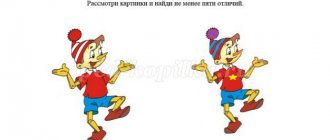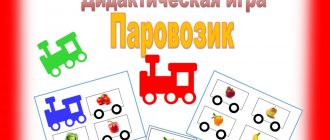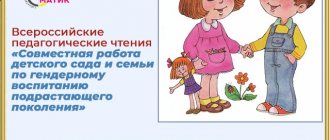Card index of Didactic games for the winter period for children 2-3 years old.
"Pick your buttons"
Objectives: To develop the ability to group objects by size.
Material: 2 boxes, large and small, buttons of different sizes (large and small) Description of the game: The teacher, together with the children, arranges the buttons into groups: the largest, largest, smallest, etc. Considering the sizes of buttons, compares and applies button to button. The adult activates the children's speech.
Topic "Ground transport"
"Cars are coming"
Objectives: Develop the need for communication and interaction, set an example of proper conflict resolution, and form friendly relationships. Follow the rules. When confronted by a partner, you should apologize and give way, otherwise the green signal will not appear.
Game description: The teacher invites the children to go for a ride in the car. Children take an imaginary steering wheel in their hands, give the signal: “Beep!”, and drive, imitating the noise of the car: “Zh-zh-zh” - to the music corresponding to the nature of the game. The teacher raises a red circle and loudly announces: the passage is closed. Children are waiting for a signal. The teacher raises the green circle and says: you can go. The children move on.
Then the teacher sits the children on chairs and uses toys to show them the play “Stubborn.”
Two cars are driving along a bridge and suddenly collide with each other. One driver (the goat) asks the other (the lamb) to give way to him, but the first driver does not want to give way. The drivers go out onto the bridge, argue, butt heads and fall into the river.
The teacher asks questions: “What happened to the cars? Who drove these cars? How did the lamb and the goat argue? What happened to them then?
After the performance, the teacher again invites the children to ride in cars. Children “drivers” should not crowd on the roads, look at the traffic lights, listen to the signal: stop or drive. If the “cars” collide, the teacher shows a yellow circle (“dispute”). The drivers say to each other: “Sorry, pass,” and one gives way to the other.
The teacher specifically stops the “machines” that collide and gives them the opportunity to resolve the dispute. After resolving each controversial situation, he comes to the conclusion: we must live together, give in to each other.
"Train"
Objectives: to help children adapt to the conditions of kindergarten, create a positive emotional climate in the group; relieving emotional stress; encourage children to interact with each other. practicing basic movements - running, walking. Description of the game: The teacher suggests playing “train”: “I am the locomotive, and you are the carriages.” Children stand in a column one after another, holding onto the clothes of the person in front. “Let’s go,” says the adult, and everyone begins to move, saying: “Choo-chu-chu.” The teacher drives the train in one direction, then in the other, then slows down, stops and says: “Stop.” After some time, the train sets off again.
Didactic games for older preschoolers 5-7 years old. Theme: Winter
Didactic games for older preschoolers on the lexical topic “Winter”
Author: Pavlova Vera Valerievna, teacher of the special group of the Municipal Educational Institution “Bendery Kindergarten No. 9”, Bendery Abstract: this selection of didactic games will be useful for educators and primary school teachers. Purpose: these didactic games can be used when conducting educational activities, in independent children's activities. Age audience: senior preschool age (5-7 years). Goal: to clarify ideas about the features of winter as a time of year, to consolidate the main changes that occur in inanimate and living nature among people when this time of year approaches. Objectives: -summarize the signs of winter; - clarify what happens in living and inanimate nature with the arrival of winter; -clarify ideas about wintering birds of the region and people helping them; - clarify your knowledge of proverbs and sayings, riddles and poems about winter. Didactic game “Name the winter words” Goal: formation of an active stock of words denoting the subject, development of imagination and creativity. Progress of the game: The teacher invites the children to remember and name 10 “winter” words. If you have difficulty, you can offer to show pictures of these natural phenomena. For each word named only by him, the player receives a chip. The one who ends up with the most chips wins. Examples of words: frost, snow, ice, frost, snowman, frost, Snow Maiden, snow fortress, snowballs, snowflakes, etc.
Didactic game “Tell me which one?” Goal: activation of children's vocabulary, expansion of ideas about the properties of objects of inanimate (living) nature. Progress of the game: The teacher distributes cards with images of inanimate objects of nature. The child selects 5 words for a given object. Examples of natural objects: snow, sun, wind, clouds, sky, ice, snowflakes
Didactic game “Continue the sentence” Goal: clarify ideas about winter and other seasons, activate vocabulary, develop coherent speech. Progress of the game: The teacher begins the sentences, the child finishes and explains his answer. If in winter the day is shorter than in spring, then in spring... If the tree is higher than the bench, then the bench... If more titmice flew to the feeder than sparrows, then titmice... If the wooden slide is higher than the ice one, then icy... If it is warmer in summer than in autumn, then in autumn... Didactic game “Big - Small” Purpose: to consolidate the use of words with diminutive suffixes in speech, to develop memory. Progress of the game: The teacher gives the children pictures depicting objects of animate or inanimate nature. Children name large and small objects. You can suggest making sentences with these words. Examples of words: snow, snowflake, snowman, sun, cloud, tree, mitten, hat, scarf...
Didactic game “Correct Mistakes” Purpose: formation of ideas about characteristic phenomena in winter, comparison of winter and other seasons, development of attention, memory, coherent speech - explanations Progress of the game: The teacher reads the sentence to the children and says that they need to listen carefully, and then correct the mistakes . The child who explains the mistake gets a chip. The one with the most chips wins. Example sentences: Summer has come, and people put on mittens and hats. Winter has come and the swallows have arrived. Spring has come, and the river is covered with ice. Summer has ended and spring has come. Summer has come, and migratory birds have flown south. Spring has come, and titmice and pigeons began to fly to the feeder. Didactic game “What will happen if you sculpt from ...” Purpose: to consolidate knowledge about the materials from which you can sculpt; activate children's vocabulary. Progress of the game: The teacher shows the children three pictures: snow, plasticine, dough and asks them to name what can be molded from this material. Each item is marked with a chip. At the end of the game, you can see what material the children are most familiar with and what crafts they suggested making. Examples: plasticine: dishes, furniture, fruits, vegetables, food, etc. Snow: snowball, fortress, bunny, snowman, snow figures, etc. Dough: bun, pie, craft, cookies, etc.
Didactic game “Select logical pairs” Purpose: making logical pairs from various subjects; development of vocabulary, logic and memory. Progress of the game: The teacher hands out pictures to the children and says that they need to find pairs with each other, and then come up with sentences with two words. Example words: snowman and broom; feeder and titmouse; boy and mitten; bear and den; crossbill and pine cones.
Didactic game “Place in order” Purpose: knowledge of the process of making a snowman; ability to explain its stages. Progress of the game: The teacher says that it is necessary to arrange the pictures in order to make a snowman. Children comment on the manufacturing process according to the diagram.
Didactic game “Which of the wintering birds gives a voice?” Goal: to consolidate the names of wintering birds and their voices; development of memory and attention. Progress of the game: The teacher hands out cards with pictures of wintering birds; children are asked to remember how this or that bird calls, recognizing it in the picture. Sparrow - tweets; crow - croaks; magpie - chirps; dove - coos; tit – shade; owl hoots.
Didactic game “Finish the proverb about winter” Goal: knowledge of proverbs and sayings about winter, development of memory and attention. Progress of the game: The teacher begins a proverb about winter, the children finish. You can play with two teams of children. The team that remembers the proverbs and sayings better wins. Examples of proverbs and sayings about winter: Take care of your nose in severe frost. The year ends and winter begins. December ends the year and begins winter. The frost is not great, but it is not good to stand. January is the beginning of the year, the middle of winter. February is a fierce month: he asks how you are wearing shoes. The sun does not shine in winter against the summer sun. Not the snow that blows, but the one that comes from above. In the winter cold, everyone is young. One night it becomes winter. I recommend that teachers of preschool education organizations use the proposed games in educational activities, leisure activities, quizzes, and in individual work.
We recommend watching:
Didactic game with sounding objects for older preschoolers Didactic game for teaching literacy to older preschoolers Didactic games for older preschoolers 5-7 years old. Topic: Wintering birds Role-playing game in kindergarten in the senior group “Celebrating the Old New Year”
Similar articles:
Story-based didactic game for older preschoolers “We are traveling on a train”
Didactic games for cognitive development “Winter”
Galina Zhigulina
Didactic games for cognitive development “Winter”
Didactic game on cognitive development (middle group)
Didactic task : Teach children to group objects according to the material from which they are made (metal, rubber, glass, wood, plastic)
;
activate children's vocabulary; cultivate observation, attention, and the ability to strictly follow the rules of the game .
Game rule: You can only place objects on a tray that is made of the same material.
Progress of the game : The teacher has a short conversation before the start of the game , clarifies the children’s knowledge that all objects are made of different materials; remember what materials they know, as well as things made from them.
Rules of the game : You need to touch, find out what the object is made of, and tell about it.
Complication: Walk around the room, find objects made of different materials and put them on a tray that is made of the same material.
Didactic game on cognitive development (middle group)
Didactic task : To teach how to relate tools to people’s professions; to cultivate an interest in the work of adults, a desire to help them, to take on the roles of people of different professions in creative games.
Game rule: Name the profession in accordance with the objects of labor. Remember where you saw such an employee.
The child takes an object and names it, the other children name who needs what for work (a hammer - a carpenter needs it)
.
If there are several tools for one profession, the teacher invites the children to find them.
Complication: Children are divided into teams: one names tools, and the other names professions.
Didactic game on cognitive development (middle group)
Didactic task : To clarify and consolidate children’s knowledge about different sports; cultivate a desire to play sports, develop resourcefulness , intelligence, and attention.
Game rule: first one to put together a picture wins (of six parts)
about one sport.
Progress of the game : The teacher has cards depicting various sports: football, hockey, volleyball, gymnastics, rowing. The game is played according to the type of cut pictures, but they are cut differently - in the middle there is a picture with an athlete. It is necessary to select for the athlete everything necessary for the game .
Using this principle, you can play a game in which children will select tools for different professions.
Didactic game on cognitive development (middle group)
"Where can I buy this"
Didactic task : To consolidate children’s knowledge that different goods are sold in different stores: grocery stores, department stores, bookstores; teaches children to distinguish between stores according to their purpose and to navigate their surroundings; cultivate a desire to help parents and make simple purchases.
Game rule: Match items with store names on large cards. The game is played on the lotto principle
Progress of the game : Children are given small pictures, each child says where in which store they can buy it. Place the card on the large card (store)
Didactic game on cognitive development (middle group)
“Does this happen or not?”
Didactic task : Develop logical thinking , the ability to notice inconsistencies in judgments.
Game rule: Whoever notices a fable must prove why this does not happen.
Progress of the game : The teacher explains the rules of the game :
- Now I will tell you about something. In my story you should notice something that does not happen. Whoever notices, after I finish, let him say why this cannot be so.
“In the summer, when the sun was shining brightly, the boys and I went for a walk. They made a slide out of snow and started sledding down it.”
Children make up their own stories.
Didactic game on cognitive development (middle group)
Didactic task : Encourage children to look at objects, remember the qualities of those objects that the child does not currently see.
Game rule: The one who the driver points to with the arrow guesses.
Homework for children with special needs on the topic “Winter. Winter months"
Topic: “Winter. Winter months. Signs of winter"
1. Talk to your child about winter. Know the signs of winter: it’s cold outside in winter, snow has fallen. There is often strong wind and frost. The sun is not shining. The polar night is coming.
2. Select at least 3 definitions. Weather in winter (what?) – frosty, snowy, cold Wind in winter – ……………..(cold, strong, prickly) Sky in winter – ……………… (cloudy, gloomy, gray) Snow (what?) - …………….(white, fluffy, beautiful) Frost (what?) - …………(strong, weak, crackling)
3. Count to 5, correctly coordinating the words: 1 snowflake - 2 - ... 3- ..... 4 - ......, 5 snowflakes; 1 day, 2 days, etc.
4. What can be said about: • Freezes - the river • Advances - ... • Whirls - ... • Flies - ....
5. Come up with your own story about winter. Plan: • What time of year is it? • What's the weather like outside? What are people wearing? • What do children do on the street, how do they play?
6. Learn the names of the winter months. Name the current one.
7. Call it “kindly”: SNOW – SNOWBALL, WIND – ………, FROST – ………SUN – ……., DAY – …….
Theme: “Winter fun”
1. Listen carefully, repeat from memory: SLEDGE, SKATE, SKI, SLIDE. Tell us when you can sled, ski, skate and slide. (Winter). Explain why you think so.
2. Change the words according to the example: Sled - snow on a sled - about snow Skates - ………… skating rink - ……….. Skis - ………….. frost - ……….. Slides - …………… winter - …………
3. Name it “affectionately”: SLEDGE – SLEDGE, SLIDES – ………, ICICLES – …….., SKATE – END, DAY – ……….., WIND – ……, RINK – ………..
4. Guess the riddles, learn any of them: Two, new, maple ones. Guys, I have two-meter soles: Two tips, two skates. They put two feet on them, sleep all summer long, and run through the big snows. Horses only love ice. (Skis) (Skates)
5. Listen to the story, answer the questions in complete sentences. Prepare a retelling of the story. ON THE HILL.
WINTER CAME. WHITE, FLUFFY SNOW FELL OUT. A SLIDE WAS BUILT IN THE YARD. THREE BOYS WITH SKIS WERE THE FIRST TO RUNN ON THE HILL. TWO GIRLS CAME SECOND. BOTH GIRLS WERE WITH SLEDGES. FIVE GUYS STARTED ROLLING ON THE SLIDE. EVERYONE HAD A LOT OF FUN.
• What time of year is it? • What kind of snow fell? • What was built in the yard? • Who was the first to run up the hill? • Who came second on the hill? • What did the two girls start riding? • How many kids started riding the slide?
Topic: “Winter. Winter months. Signs of winter"
1. Remember what time of year it is. Explain why you think so. Remember what the first month of winter is. Explain the words: frosty, harsh, snowfall, drifting snow.
2. Tell us what the weather is like in winter, how snowy and frosty it can be. (Choose at least 4 definitions) for example: the weather in winter can be cloudy, cold, snowy, frosty, etc.
3. Count to 8, correctly coordinating the words: 1 white snowflake - 2 - ... 3- ..... 4 - ...... ; 1 cold day, 2 cold days, etc.
4. What can be said about: • Freezes - the river • Advances - ... • Whirls - ... • Flies - ....
1. Come up with your own story about winter. Plan: • What time of year is it? • What's the weather like outside? What are people wearing? • What do children do on the street, how do they play?
2. Collect sentences: • Snow drift, street, sweeping, by • Window, frost, pattern, on, painted • Sasha, on, skating, figure, practice, skating rink.
3. Development of logical thinking:
• Thaws gave way to frosts.
What happened in the beginning, what then? • Which are fewer winters or winter months? Author of the material: Kravchuk Irina Anatolyevna





